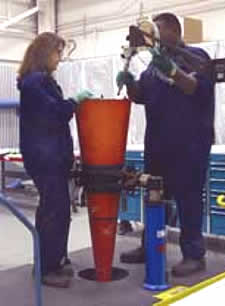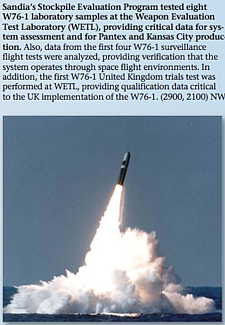British Submarines to Receive Upgraded US Nuclear Warhead
Sea-launched ballistic missiles on British ballistic missile submarines will be armed with the upgraded W76-1 nuclear warhead currently in production in the United States, according to a report from Sandia National Laboratories.
According to the Labs Accomplishments from March 2011, “the first W76-1 United Kingdom trials test was performed at WETL [Weapon Evaluation Test Laboratory], providing qualification data critical to the UK implementation of the W76-1.”

The Royal Navy plans to “integrate” the US W76-1/Mk4A warhead onto British SSBNs.
Rumors have long existed that the nuclear warhead currently used on British sea-launched ballistic missiles (SLBMs) is very similar to the U.S. W76 warhead deployed on American SLBMs. Official sources normally don’t give U.S. warhead designations for the British warhead but use another name. A declassified document published by the National Nuclear Security Administration (NNSA) in 1999, which I published in 2008, described maintenance work on the W76 warhead but called the British version the “UK Trident System.”
 |
| Labs Accomplishments from Sandia National Laboratories describes “the first W76-1 United Kingdom trial test” and “UK implementation of the W76-1.” Download the publication here. |
The Sandia report, on the contrary, explicitly uses the U.S. warhead designation for the warhead on British SLBMs: W76-1.
Approximately 1,200 W76-1s are current in production at the Pantex Plant in Texas. The W76-1 is an upgraded version of the W76-0 (or simply W76) produced between 1978 and 1987. In its full configuration, the upgraded weapon is known as the W76-1/Mk4A, where the Mk4A is the designation for the cone-shaped reentry body that contains the W76-1 warhead.
After first denying it, the British government has since confirmed that the Mk4A reentry body is being integrated onto the British SLBMs but it has been unclear which warhead it will carry: the existing warhead or the new W76-1. The Sandia report appears to show that the United Kingdom will get the full package: W76-1/Mk4A.
HMS Vanguard launches US-supplied Trident II D5 SLBM off Florida in October 2005. In the future, missiles on British submarines will carry US-supplied W76-1/Mk4A nuclear warheads.
The upgrade extends the service life by another 30 years to arm U.S. and British nuclear-powered ballistic missile submarines (SSBNs) through the 2040s. That timeline fits the 2010 British Strategic Defence Review finding that “a replacement warhead is not required until at least the 2030s.”
 |
| HMS Vanguard launches US-supplied Trident II D5 SLBM off Florida in October 2005. In the future, missiles on British submarines will carry US-supplied W76-1/Mk4A nuclear warheads. |
.
The transfer of W76-1/Mk4A warheads to the United Kingdom further erodes British claims about having an “independent” deterrent. The missiles on the SSBNs are leased from the U.S. Navy, the missile compartment on the next-generation SSBN will be supplied by the United States, and new reactor cores that last the life of future submarines hint of substantial U.S. nuclear assistance.
The transfer of nuclear technology from the United States to Britain is authorized by the 1958 US-UK Mutual Defense Agreement, which was most recently updated in 2004 and extended through 2014 to permit the “transfer of nonnuclear parts, source, byproduct, special nuclear materials, and other material and technology for nuclear weapons and military reactors” between the two countries. The will text is secret but a reconstructed version is here (see note 3).
Acknowledgements: Thanks to Nick Ritchie at Bradford University (“US-UK Special Relationship”) and John Ainslie at Scottish CND.
This publication was made possible by a grant from Carnegie Corporation of New York and Ploughshares Fund. The statements made and views expressed are solely the responsibility of the author.
Satellite imagery has long served as a tool for observing on-the-ground activity worldwide, and offers especially valuable insights into the operation, development, and physical features related to nuclear technology.
This report outlines a framework relying on “Cooperative Technical Means” for effective arms control verification based on remote sensing, avoiding on-site inspections but maintaining a level of transparency that allows for immediate detection of changes in nuclear posture or a significant build-up above agreed limits.
The grant comes from the Carnegie Corporation of New York (CCNY) to investigate, alongside The British American Security Information Council (BASIC), the associated impact on nuclear stability.
Satellite imagery of RAF Lakenheath reveals new construction of a security perimeter around ten protective aircraft shelters in the designated nuclear area, the latest measure in a series of upgrades as the base prepares for the ability to store U.S. nuclear weapons.